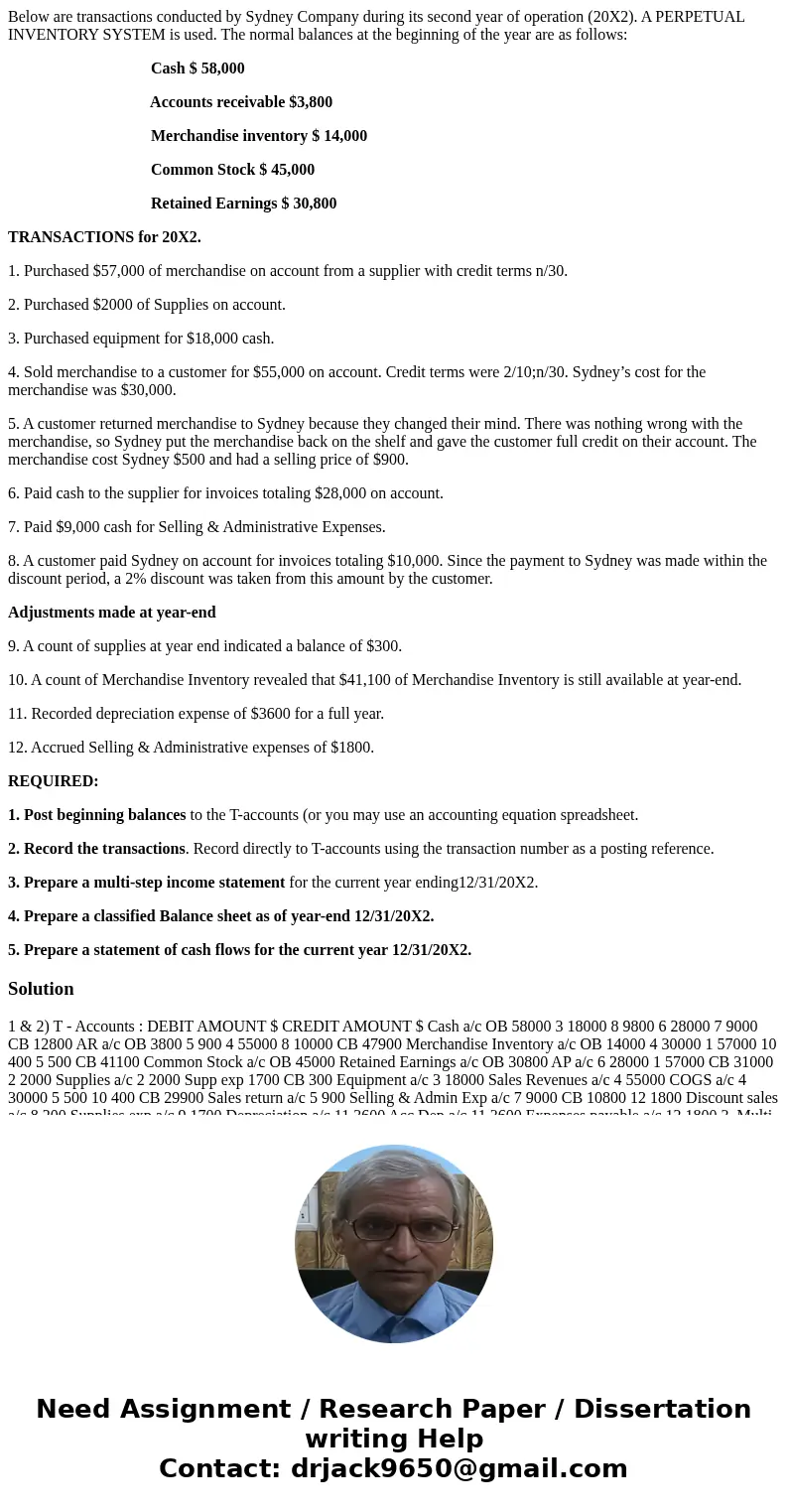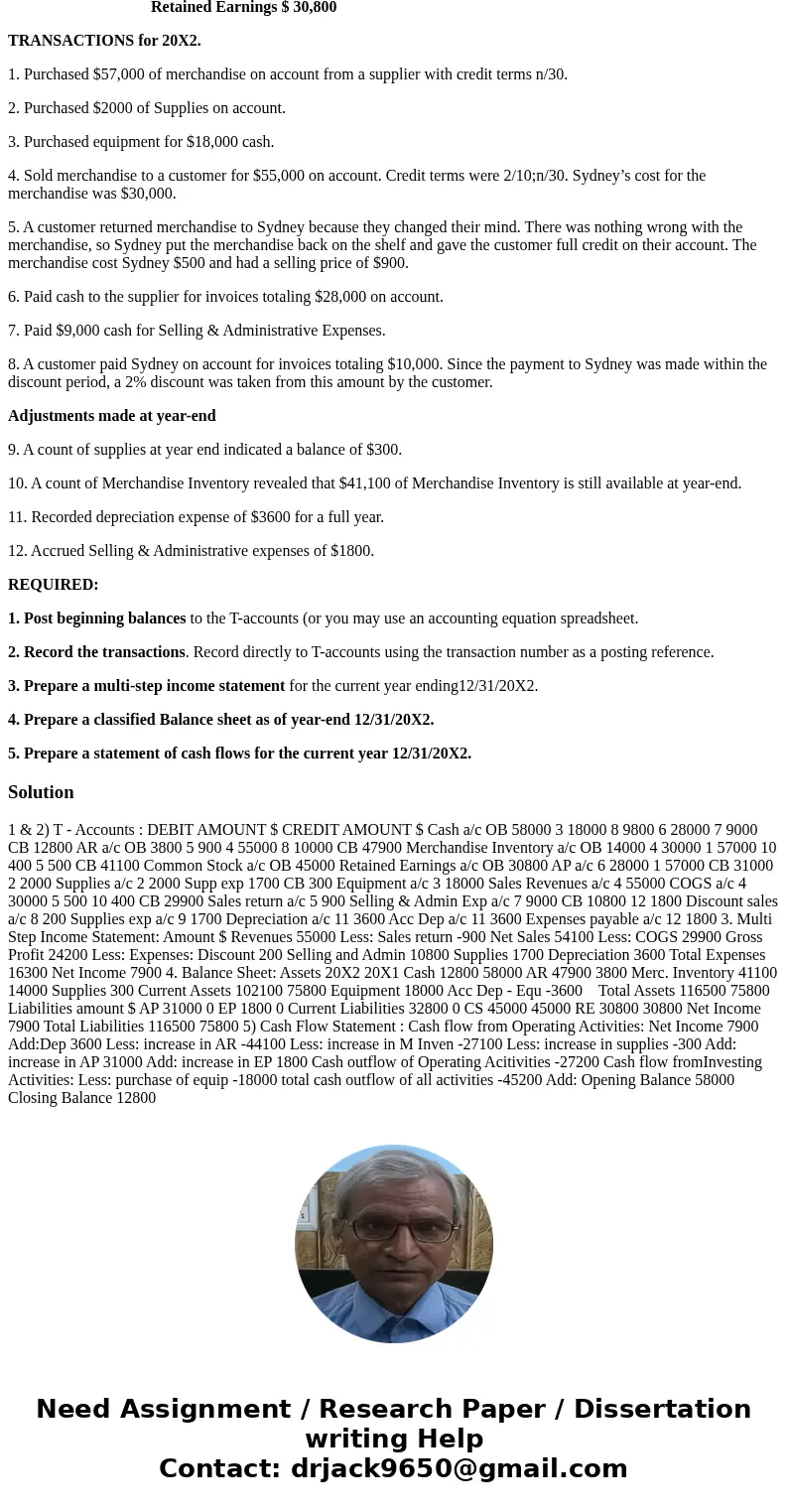Below are transactions conducted by Sydney Company during it
Below are transactions conducted by Sydney Company during its second year of operation (20X2). A PERPETUAL INVENTORY SYSTEM is used. The normal balances at the beginning of the year are as follows:
Cash $ 58,000
Accounts receivable $3,800
Merchandise inventory $ 14,000
Common Stock $ 45,000
Retained Earnings $ 30,800
TRANSACTIONS for 20X2.
1. Purchased $57,000 of merchandise on account from a supplier with credit terms n/30.
2. Purchased $2000 of Supplies on account.
3. Purchased equipment for $18,000 cash.
4. Sold merchandise to a customer for $55,000 on account. Credit terms were 2/10;n/30. Sydney’s cost for the merchandise was $30,000.
5. A customer returned merchandise to Sydney because they changed their mind. There was nothing wrong with the merchandise, so Sydney put the merchandise back on the shelf and gave the customer full credit on their account. The merchandise cost Sydney $500 and had a selling price of $900.
6. Paid cash to the supplier for invoices totaling $28,000 on account.
7. Paid $9,000 cash for Selling & Administrative Expenses.
8. A customer paid Sydney on account for invoices totaling $10,000. Since the payment to Sydney was made within the discount period, a 2% discount was taken from this amount by the customer.
Adjustments made at year-end
9. A count of supplies at year end indicated a balance of $300.
10. A count of Merchandise Inventory revealed that $41,100 of Merchandise Inventory is still available at year-end.
11. Recorded depreciation expense of $3600 for a full year.
12. Accrued Selling & Administrative expenses of $1800.
REQUIRED:
1. Post beginning balances to the T-accounts (or you may use an accounting equation spreadsheet.
2. Record the transactions. Record directly to T-accounts using the transaction number as a posting reference.
3. Prepare a multi-step income statement for the current year ending12/31/20X2.
4. Prepare a classified Balance sheet as of year-end 12/31/20X2.
5. Prepare a statement of cash flows for the current year 12/31/20X2.
Solution
1 & 2) T - Accounts : DEBIT AMOUNT $ CREDIT AMOUNT $ Cash a/c OB 58000 3 18000 8 9800 6 28000 7 9000 CB 12800 AR a/c OB 3800 5 900 4 55000 8 10000 CB 47900 Merchandise Inventory a/c OB 14000 4 30000 1 57000 10 400 5 500 CB 41100 Common Stock a/c OB 45000 Retained Earnings a/c OB 30800 AP a/c 6 28000 1 57000 CB 31000 2 2000 Supplies a/c 2 2000 Supp exp 1700 CB 300 Equipment a/c 3 18000 Sales Revenues a/c 4 55000 COGS a/c 4 30000 5 500 10 400 CB 29900 Sales return a/c 5 900 Selling & Admin Exp a/c 7 9000 CB 10800 12 1800 Discount sales a/c 8 200 Supplies exp a/c 9 1700 Depreciation a/c 11 3600 Acc Dep a/c 11 3600 Expenses payable a/c 12 1800 3. Multi Step Income Statement: Amount $ Revenues 55000 Less: Sales return -900 Net Sales 54100 Less: COGS 29900 Gross Profit 24200 Less: Expenses: Discount 200 Selling and Admin 10800 Supplies 1700 Depreciation 3600 Total Expenses 16300 Net Income 7900 4. Balance Sheet: Assets 20X2 20X1 Cash 12800 58000 AR 47900 3800 Merc. Inventory 41100 14000 Supplies 300 Current Assets 102100 75800 Equipment 18000 Acc Dep - Equ -3600 Total Assets 116500 75800 Liabilities amount $ AP 31000 0 EP 1800 0 Current Liabilities 32800 0 CS 45000 45000 RE 30800 30800 Net Income 7900 Total Liabilities 116500 75800 5) Cash Flow Statement : Cash flow from Operating Activities: Net Income 7900 Add:Dep 3600 Less: increase in AR -44100 Less: increase in M Inven -27100 Less: increase in supplies -300 Add: increase in AP 31000 Add: increase in EP 1800 Cash outflow of Operating Acitivities -27200 Cash flow fromInvesting Activities: Less: purchase of equip -18000 total cash outflow of all activities -45200 Add: Opening Balance 58000 Closing Balance 12800

 Homework Sourse
Homework Sourse